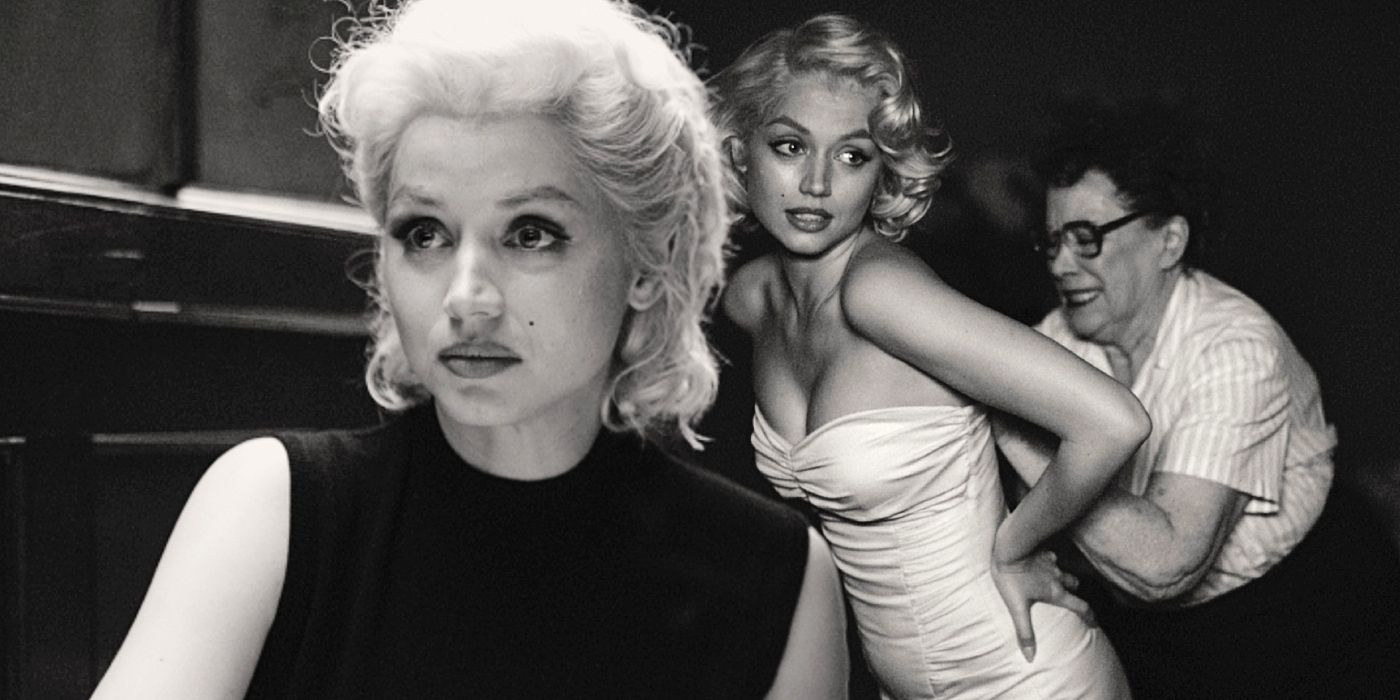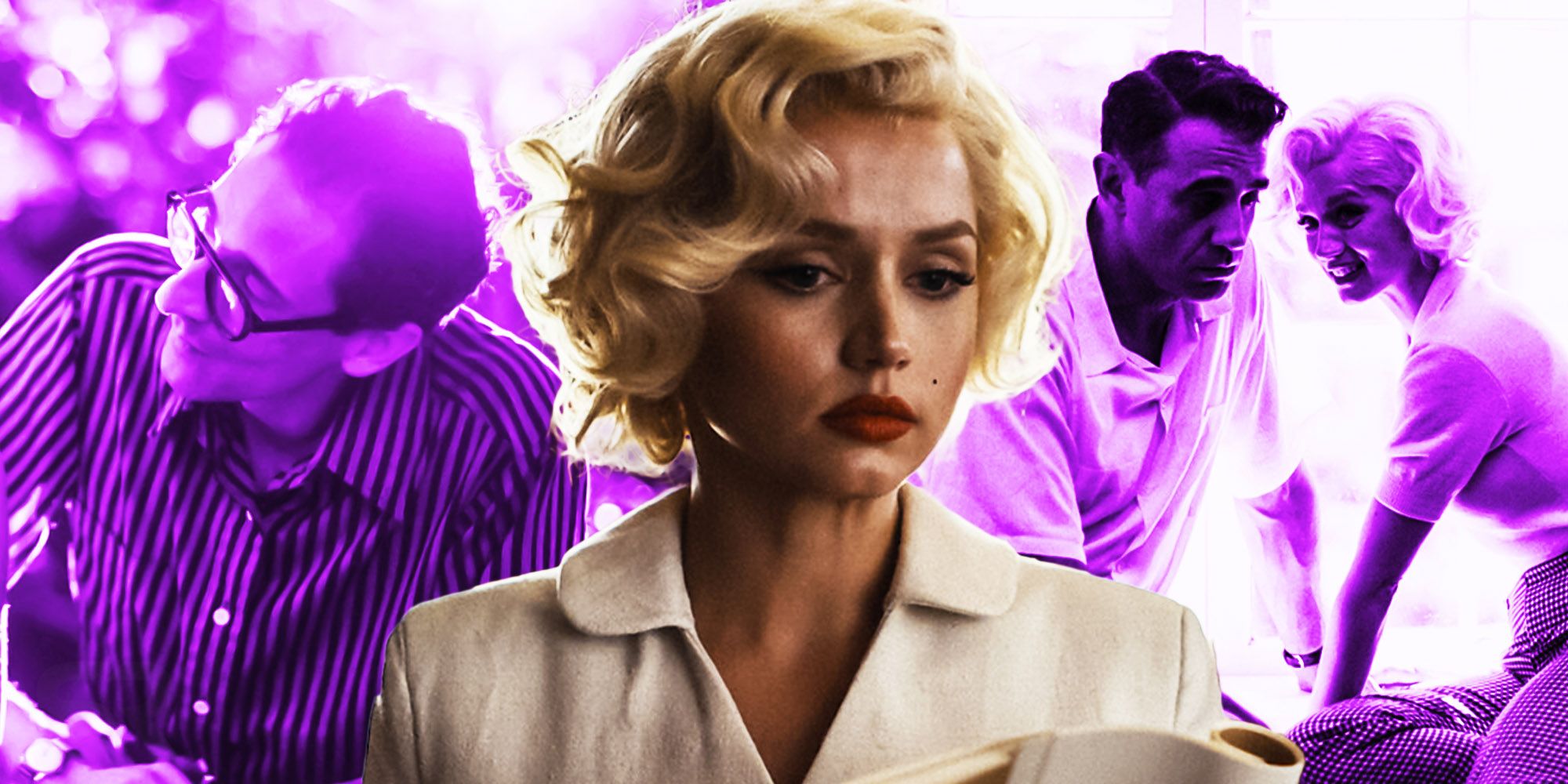While Ana de Armas does a great job at capturing the essence of Marilyn Monroe in Netflix’s drama film Blonde, the film's storytelling cannot say that it affords de Armas the same courtesy. Blonde’s release on the streaming service has garnered mixed reactions, with Andrew Dominik, director and screenplay writer, classifying the film as “anti-biopic” for its fictionalized depiction of actress Marilyn Monroe’s life. But amidst all the controversy on whether the film was good or bad, one thing that unites all commentaries about Blonde is Ana de Armas’ stellar portrayal of the Hollywood star.
SCREENRANT VIDEO OF THE DAY
Based on Joyce Carol Oates’ novel of the same name, Dominik’s Blonde dispenses a visually disconcerting watch through its shifting frames from color to black and white and haphazard implementation of four different aspect ratios that conform to the blonde bombshell’s iconography in popular culture. Encompassing the significant strokes of Marilyn Monroe’s booming career and glimpses of her troubled life as Norma Jeane Mortenson, Knives Out actress Ana de Armas transforms into the 1950s icon, dramatizing her life in inaccurate detail. Blonde's take on Marilyn Monroe has received divisive criticism, with the most common complaint pertaining to the film’s victimization of Monroe and the most common praise being de Armas’ performance.
Despite Blonde being riddled with misogynistic undertones, its lead actress powers through, delivering a lasting impression on audiences which offers the film a saving grace. Ana de Armas shines as Marilyn Monroe, embodying the sultry and captivating persona, so much so that the film becomes unworthy of her performance. Given that Blonde’s narrative comes with a limited lens, de Armas is unfortunately curtailed by the film’s adamant presentation of Marilyn Monroe’s fame and its abusive consequences.
Ana De Armas' Marilyn Monroe Performance Is Really Great

It takes a great talent to get into someone else's skin and exude their essence on the screen and Ana de Armas did just that in Blonde. Similar to any actor helming a biopic film, de Armas underwent a rigorous process to morph into Norma Jeane’s screen alter ego, Marilyn Monroe. While filming for the first Knives Out film, de Armas started her preparation to become Monroe (via Variety) in between takes and after shoots. Meticulously working with an accent coach, de Armas spent hours on end trying to nail Monroe’s voice and accent, simultaneously working to mask her native Cuban one given that English isn’t her first language. De Armas obsessed over Monroe’s filmography, recorded interviews, and other media she could find on the internet, realizing that mimicking Monroe’s movements would not be enough for a film this ambitious; rather understanding the late actress on a deeper level was required to serve justice to the role.
Even when filming for Blonde began, the No Time To Die actress' dedication knew no bounds as she played Monroe's films and musical numbers on repeat during her breaks and make-up sessions, fully internalizing the character as her own. Director Dominik also had behind-the-scenes crew don period wardrobe and continuously filmed de Armas separate from the actual takes, encouraging her to maintain her Marilyn Monroe persona which adds to the overall effect seen in the final cut of Blonde. Naturally, with such a methodical process, de Armas was bound to create a stunning portrait of Monroe, exceeding all expectations. Ana de Armas' evocation of Marilyn Monroe emanates her quintessence. And while her depiction of the Hollywood starlet isn't pitch perfect, it keeps Marilyn's spirit.
Blonde's Marilyn Monroe Story Has A Lot Of Problems

While biopics are never really 100% accurate and often created for entertainment, Dominik's film takes it a step further by tagging Blonde's Marilyn Monroe story as a reversal of the traditional biopic and makes a spectacle of Monroe’s dark chapters. Going through a significant number of events in its almost three-hour runtime, Blonde visualizes Marilyn Monroe’s internal monologue to a disadvantage. It frames the storytelling to the point that it victimizes Marilyn Monroe as someone who allows things to happen to her without evident dissent or struggle. The staggering visual opus means to represent Marilyn’s inner turmoil from the inside-out, yet it does her (and Ana de Armas) a disservice by furnishing passivity from its central character.
Not to mention Blonde’s blatant fabrication of completely imagined (and graphically violent) interactions between Marilyn Monroe and her other real-life contemporaries. This includes Monroe’s fictionalized throuple relationship with Cass Chaplin and Eddy Robinson; while the actress was certainly rumored to have gotten caught up with both men, there is no basis that they were all involved together. What’s more, the detailed abortion scene (while it may have been plausible to happen for a woman of her status of fame and fortune) also didn’t have any concrete evidence that it happened in reality. While these are only two of the many inconsistencies between Blonde and real life, the film has a number of problems that could have been amended if only the heart of Marilyn Monroe had ever been considered in Blonde’s production. Granted that Blonde is created as a dreamscape-style narration akin to memory recall, its decision of traversing Norma Jeane’s short life through the lens of her abusers flatlines any meaning to who Marilyn Monroe was.
Ana De Armas' Marilyn Monroe Could Have Been Even Better

Despite the raving reviews of Ana de Armas' Marilyn Monroe role, Blonde could have been better. The biopic film genre is taxed with a formula that’s a tad boring for most audiences, leaning toward historical telling as opposed to intrigue and drama which considerably makes Blonde’s creative liberties justified, in a sense. However, it doesn’t change the fact that biopics are based on real people, which requires a delicacy in their execution to ensure they pay homage to their real-life counterparts, honoring their legacies rather than monetizing them for the sake of cheap exploitation. Blonde fails Ana de Armas’ Marilyn Monroe by reducing the character’s direct impact in the overall story, fixing her as a recipient of actions rather than an actor with definitive wants and needs.
Blonde’s tonal constraint deprives Deep Water's Ana de Armas room to perform the nuances of Monroe’s life that would have rendered a bigger picture of who she was. Instead, the feature primarily focuses on Marilyn's painful anecdotes and dims the atmosphere of supposedly happy ones which results in Blonde being devoid of any empathy for its subject. While Blonde’s aesthetic is commendable for subverting film structure, it ultimately became its downfall by causing a quasi-biased narration – stripping a powerful icon’s tale by removing any semblance of agency and ironically, typecasting her into her own biopic.
